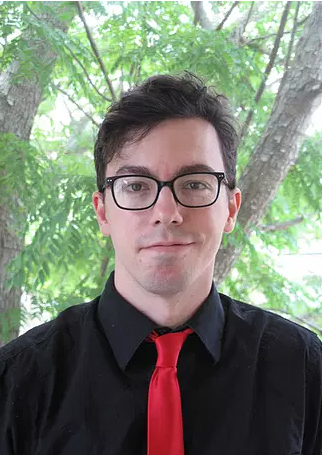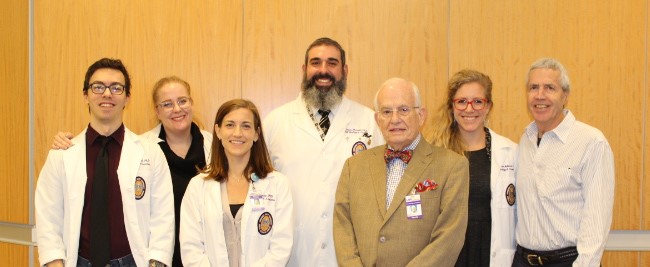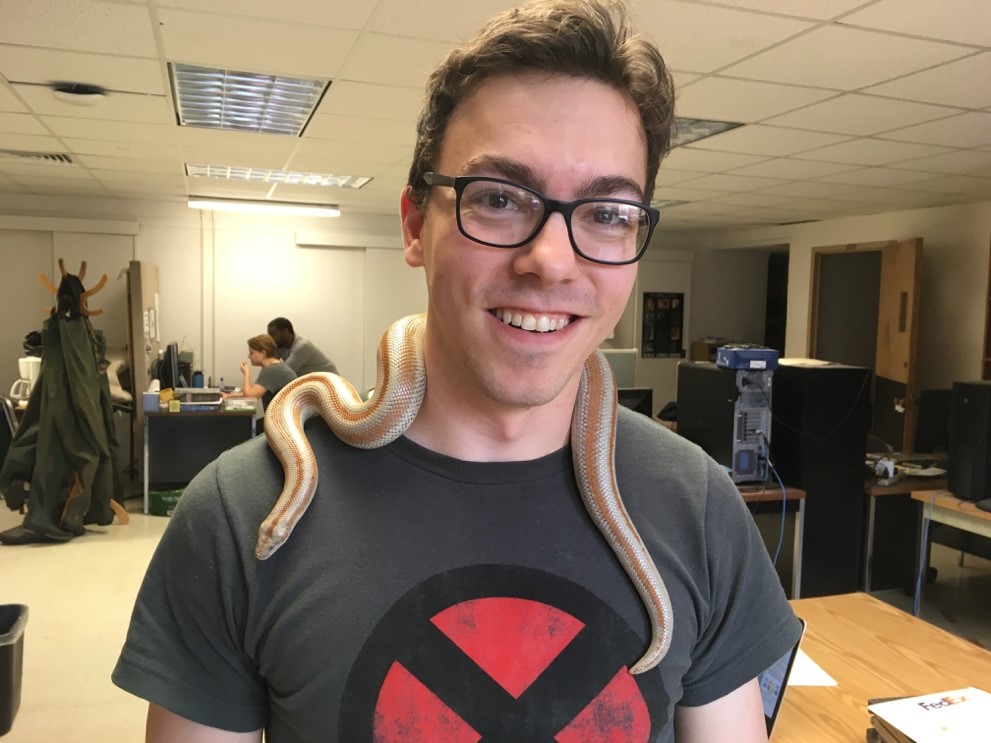
Brandon P. Hedrick, Ph.D.
Brandon P. Hedrick, Ph.D.
Assistant Professor - Research
Department of Cell Biology and Anatomy
Assistant Professor - Research
Department of Cell Biology and Anatomy
1901 Perdido Street, Room 6124A
2019 Medical Gross Anatomy Faculty: (from left to right) Brandon P. Hedrick, Sarah
New Orleans, LA 70112
(504) 568-7183
bhedri@lsuhsc.edu

Williams, Terrel Sugar Master, Jay Mussell, Jim Jeter, Sonya Van Nuland, Ted Weyand
Brandon Hedrick with a Kenyan sand boa (Gongylophis colubrinus)
www.bphedrick.com (Research Website)

at the University of Massachusetts
Degrees
BS Biology & BS Environmental Sciences - 2010
Emory University, Atlanta, GA
PhD Earth and Environmental Sciences - 2015
University of Pennsylvania, Philadelphia, PA
Bio
Assistant Professor, Louisiana State University, School of Medicine, Department of Cell Biology and Anatomy, New Orleans, USA, July 2019–Present
Junior Research Fellow, Wolfson College, University of Oxford, Oxford, UK, January 2019–July 2019
Postdoctoral Research Assistant, Laboratory of Dr. Roger Benson,
Department of Earth Sciences, University of Oxford, Oxford, UK September 2018–July 2019
National Science Foundation Postdoctoral Research Fellowship in Biology (PRFB),
Laboratory of Dr. Stephanie Pierce, August 2017– August 2018
Department of Organismic and Evolutionary Biology, Harvard University, Cambridge
MA, USA,
Laboratory of Dr. Elizabeth Dumont, August 2016–August 2017
Department of Biology, University of Massachusetts–Amherst, Amherst MA, USA,
Postdoctoral Fellow, Laboratory of Dr. Elizabeth Dumont, July 2015– August 2016,
Department of Biology, University of Massachusetts–Amherst, Amherst, MA, USA
Research Interests
I am an evolutionary biologist, comparative anatomist, and ecologist interested primarily in questions relating to ecomorphology and macroevolutionary trends. While I have worked on a wide variety of vertebrate groups (sharks, dinosaurs, amphibians, birds), my work has centered on mammalian evolution, particularly that of bats.
Current Research:
Bat Sensory Ecology and Morphometry: New World leaf-nosed bats have diverged into a wide variety of dietary niches, ranging from to insect-eating bats to blood-eating vampire bats to fruit-eating bats capable of biting into figs to nectar-feeding bats that engorge their tongues with blood to drink nectar in flowers. These different bats use different sensory systems to find their food (hearing for echolocation versus vision for finding bright fruits). Working with collaborators from Stony Brook, UC Merced, UCLA, and the Queen Mary University of London, I am studying the evolution of diet and sensory morphometry (e.g. eye globe size, olfactory bulb size) in New World leaf-nosed bats, analyzed using diffusible contrast-enhanced iodine staining, to quantify potential trade-offs in sensory systems.
Mammal Forelimb Evolution: Mammals have evolved into a wide variety of niches, with many of these niches requiring substantial remodeling of the forelimb (e.g., flying in bats, digging in moles). I am studying the internal morphology of mammalian forelimbs using cross-sectional geometry analyses and external morphology using 3D geometric morphometrics to better understand convergence in mammalian forelimb structure and the coupling and decoupling of rates of morphological evolution in the forelimb and rates of speciation and extinction.
Salamander Ecology: Salamanders make up an important part of the ecosystems that they inhabit. However, much of their movement and land-use occurs underground, making their behavior particularly difficult to study. A range of researchers from across the United States have formed the Salamander Population Adaptation Research Collaboration Network (SPARCnet, https://seansterrett.wixsite.com/sparcnet) to understand red-backed salamander behavior across their range (from North Carolina to Canada). As part of this group, I have studied how lungless salamanders, like red-backed salamanders, use the landscapes they inhabit with artificial cover objects in Massachusetts.
Teaching Activities
ANAT 100: Medical Gross Anatomy (2019–Present)
HLSC 2412: Nursing Gross Anatomy (2019–Present)
ANAT 279: Introduction to Biostatistics (2020)
ANAT 291: Anatomy Journal Club (2020- Present)
Selected Publications
Hedrick, B. P., Dickson, B., Dumont, E. R., Pierce, S. E. 2020. The Evolutionary Success of Rodents Is Not Linked to the Evolution of Locomotor Innovation. Scientific Reports 10:717.
Hedrick, B. P., Vander Linden, A.*, Cox, S., Watt, E., O’Roark, P., Cordero, S. A, Sutherland, C. 2019. Keeping salamanders off the streets: An assessment of one of the first amphibian road tunnels in the United States 30 years after installation. Journal of Urban Ecology 5(1): https://doi.org/10.1093/jue/juz023
Hedrick, B. P., Mutumi, G. L., Munteanu, V. D.*, Sadier, A., Davies, K. T. J., Rossiter, S. J., Sears, K. E., Dávalos, L. M., Dumont, E. R. 2019. Morphological diversification under high integration in a hyper diverse mammal clade. Journal of Mammalian Evolution.
Hedrick, B. P., Cordero, S. A., Zanno, L. E., Noto, C., Dodson, P. 2019. Quantifying shape and ecology in avian pedal claws: the relationship between the bony core and keratinous sheath. Ecology and Evolution. 9:11545–11556.
Hedrick, B. P., Antalek-Schrag, P.*, Conith, A. J., Natanson, L., and Brennan, P. L. R. 2019. High variance and asymmetry in the shape of the Spiny Dogfish Shark vagina revealed by 2D and 3D geometric morphometrics. Journal of Zoology. https://doi.org/10.1111/jzo.12653
Hedrick, B. P., Schachner, E. R. Rivera, G., Dodson, P., and Pierce, S. E. 2019. The effects of skeletal asymmetry on biological variation in the fossil record. Paleobiology 45(1): 154–166. https://doi.org/10.1017/pab.2018.42
Hedrick, B. P. and Dumont, E. R. 2018. Putting the Leaf-Nosed Bats in Context: A Geometric Morphometric Analysis of the Skulls and Jaws of the Three Largest Families of Bats. Journal of Mammalogy 99 (5): 1042–1054. https://doi.org/10.1093/jmammal/gyy101
Hedrick, B. P., Yohe, L., Vander Linden, A.*, Davalos, L., Sears, K., Sadier, A., Rossiter, S. J., Davies, K. T. J. and Dumont, E. 2018. Assessing Soft-Tissue Shrinkage Estimates in Museum Specimens Imaged With Diffusible Iodine-Based Contrast-Enhanced Computed Tomography (diceCT). Microscopy and Microanalysis 24 (3): 284–291. https://doi.org/10.1017/S1431927618000399

 myLSUHSC
myLSUHSC